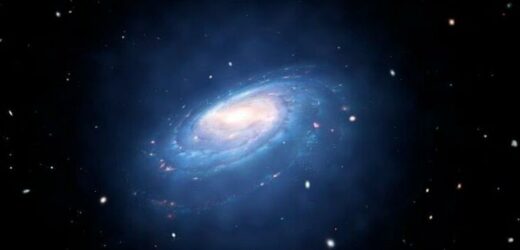Dark matter: NASA details findings of Hubble Telescope study
We use your sign-up to provide content in ways you’ve consented to and to improve our understanding of you. This may include adverts from us and 3rd parties based on our understanding. You can unsubscribe at any time. More info
Physicists believe that 13.8 billion years ago, when the universe was less than a second old, it underwent a sudden and rapid period of expansion that is dubbed “inflation”. This inflationary period lasted but a fraction of a second — but it saw the cosmos increase in volume by a factor of a “quinvigintillion” (that is, 10⁷⁸). It also amplified minute quantum fluctuations in the fabric of space-time into much larger disturbances, thereby helping to generate the structure of the universe around which stars and galaxies would eventually form.
Exactly what caused inflation, however, remains something of a mystery — with many physicists speculating that there may be a field mediated by a particle dubbed the “inflaton” which was responsible for increasing the size of space.
If it exists, the inflaton is probably similar to, albeit lighter than, the Higgs boson — the particle first detected by the Large Hadron Collider in 2012 that gives other particles mass.
And when the inflationary period of universal history ended, the experts believe, the inflaton would have decayed filling space with a hot and dense plasma and leading to the creation of all the other particles we know of today.
Given this, it would follow that the inflaton is also the progenitor of dark matter — the mysterious material whose presence we can infer from the impact it has on the motions of stars and galaxies, but that is otherwise invisible because it does not absorb, reflect or emit light or any other form of electromagnetic radiation.


As astrophysicist Professor Paul Sutter of the State University of New York at Stony Brook explained on Space.com, dark matter appears to account for more than 80 percent of all the matter in the universe.
He said: “Physicists have spent decades searching for any hints of a direct interaction between dark matter particles and normal matter, to no avail.
“If dark matter is indeed a particle, then it really, really doesn’t like talking to normal matter.
“This non-detection of dark matter is quite annoying for the story of inflation.
“If dark matter doesn’t talk to normal matter, then there’s little reason why the inflaton should create dark matter along with normal matter in the early universe.”


In their study, physicists Professor Oleg Lebedev and Jong-Hyun Yoon of the University of Helsinki have proposed a theoretical mechanism to resolve this apparent paradox.
They worked with the assumption that, given its reluctance to interact with other forms of matter, the dark matter particle must have been produced in an unusual way at the end of the universe’s inflationary epoch.
The duo first turned their attention to modelling the behaviour of inflation particles just before they decayed.
Prof Sutton said: “At the end of inflation, right before the inflaton goes away and gives rise to the particle zoo of our universe, the inflaton sloshes around the cosmos like a ball that just rolled down a steep hill but hasn’t settled down yet.”
“Cosmologists call this step the preheating phase of the inflaton decay, and it can give rise to some crazy physics.”
Part of this craziness during inflation, Prof Lebedev and Mr Yoon propose, includes an increased role for gravity in particle reactions — including channels by which the inflation might decay into dark matter particles.
If the pair are correct in their theory, then this could mean that dark matter was formed in the universe before its regular counterparts.
DON’T MISS:
Sturgeon humiliated: Shell ‘will restart Cambo oilfield’ project [INSIGHT]
‘I am NOT locking down’ Britons defiantly stand against Covid curbs [REPORT]
Putin panics as Nigeria offers to plug EU’s Russian supply gap [ANALYSIS]

As Prof Sutter notes, however, the work is purely theoretical — and relies on a lot of assumptions that will need to be tested by future work.
He said: “Most importantly, physicists aren’t exactly sure how gravity interacts with particles.
“This is the regime of quantum gravity, a theory of strong gravity at small scales, which is the current holy grail of modern physics.
“So, for their work, the co-authors of the paper had to make a lot of assumptions as to how gravity operated at these scales.”
A preprint of the researchers’ article, which has not yet been peer-reviewed, can be read on the arXiv repository.
Source: Read Full Article


